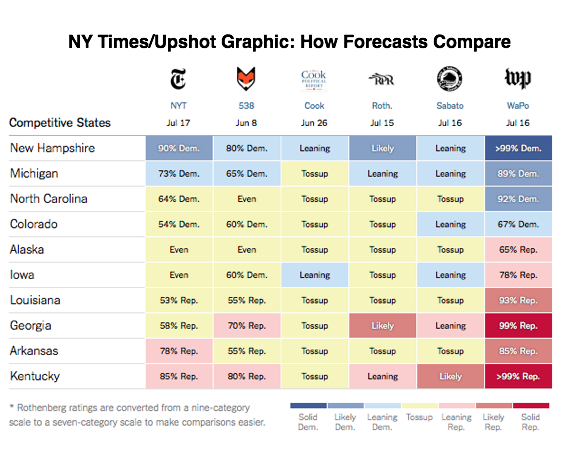
Two new polls show a close Colorado Senate race, but with differing margins. Washington Post modelers explain why their Senate forecast is so confident of a GOP victory. And is Romneymentum making a comeback? This is HuffPollster for Thursday, July 17, 2014.
QUINNIPIAC FINDS 'TIED' RACE IN COLORADO - "The closely-watched U.S. Senate race is tied with 44 percent for U.S. Rep. Cory Gardner, the Republican challenger, and 42 percent for Sen. Mark Udall, the Democratic incumbent, according to a Quinnipiac University poll released today. Another 10 percent are undecided. This compares to the results of an April 24 survey by the independent Quinnipiac University showing Sen. Udall at 45 percent to 44 percent for Rep. Gardner. [Quinnipiac]
Closer than NBC/Marist - Another poll also released this week by NBC/Marist gave Udall a 7-point lead, 48 percent to 41 percent. The differences between the two polls may be less dramatic than the margins make it appear. Both find roughly the same support for Gardner, while the difference in Udall's support measured by the two polls (48 vs 42 percent) is on the edge of what could be explained by each poll's respective margin of sampling error. [Marist]
Most CO polls show a close race - While many have come from partisan pollsters or sponsors, more than a dozen polls conducted since March have all shown a close race with 10 of 14 giving Udall a slight edge. The HuffPost Pollster poll model now shows a margin of less than one percentage point (44.9 to 44.5 percent) currently separating Udall and Gardner. Separately, the National Journal's Josh Kraushaar reports, via Twitter, that both campaign "from their internals," see a "very close race, within the margin of error." [Pollster chart, @HotlineJosh]
WHY IS THE WASHINGTON POST MODEL MORE CONFIDENT OF A GOP VICTORY? - John Sides: "Our forecast combines both (1) a model drawing on factors from the political landscape and (2) a polling average. The combination is simply pessimistic for Democrats. Our forecast is pessimistic first because the political landscape tilts in Republicans’ favor. It is a midterm year, and because of the 'midterm penalty' the president’s party typically loses seats in Congress. Moreover, the president is not that popular. ...when we say that a candidate has a 99 percent chance of winning, it reflects the relatively low uncertainty we have about that race. When we simulate hypothetical elections over and over to generate a percent chance of winning, relatively few hypothetical elections end up with that candidate winning….[O]ne possible difference was the Upshot’s greater reliance on early polls. Although we have subsequently factored the polls into our forecast, we put less weight on them in key races than does the Upshot. We think this continues to make a difference.…Our view is that handicappers [like Cook Political Report, the Rothenberg Report and Larry Sabato’s Crystal Ball] can often provide a granular sense of individual races that can’t be easily captured in models….In any case, the point is not that forecasting models are always and everywhere superior. It is just that how those models weigh information may diverge from how others do so." [NYT]
-Drew Linzer: "WaPo forecast is (mostly) in same dir as others, just more confident...Question is whether the @monkeycageblog forecasts are over-confident, or the others are under. Both are possible." [@DrewLinzer here and here]
CLINTON, HUCKABEE STAND OUT ON FAVORABILITY - Jeffrey M. Jones: "Hillary Clinton is currently the best known and best liked of 16 potential 2016 presidential candidates tested in a July 710 Gallup poll, due to her 91% familiarity score and +19 net favorable rating. The net favorable is based on her 55% favorable and 36% unfavorable ratings….Former Arkansas governor and current talk show host Mike Huckabee is arguably in a slightly better position image-wise among the national adult population than other potential Republican presidential candidates. " [Gallup]

House effect? - Gallup's latest poll gave Clinton a net +19 favorable rating, significantly higher than HuffPollster's average, which puts her at +7 among all polls, and +11.6 among other live-caller surveys. That difference doesn't appear specific to this release: Gallup has given Clinton a consistently higher-than-average ratings since 2011. Their newest poll also found relatively strong net favorables for several of the other politicians they polled on, including Chris Christie, Marco Rubio, Rand Paul and Jeb Bush. [HuffPollster]
HUFFPOLLSTER VIA EMAIL! - You can receive this daily update every weekday via email! Just click here, enter your email address, and and click "sign up." That's all there is to it (and you can unsubscribe anytime).
THURSDAY'S 'OUTLIERS' - Links to the best of news at the intersection of polling, politics and political data:
-Hillary Clinton dominates Iowa and New Hampshire primary polls, but appears more vulnerable in a general election. [NBC]
-Americans of all political persuasions are about equally likely to view domestic issues as more serious than international ones. [NBC]
-Harry Enten reviews polls on the 2014 races for governor. [538]
-Kyle Kondik notes a hidden hurdle facing Republicans: They haven't defeated more than two Democratic Senate incumbents since 1980. [Sabato]
-Jim Hobart (R) shares data on early voting in North Carolina. [POS]
-Republicans in some early primary states say they'd be open to voting for Mitt Romney again, a Republican polls finds. [Vox Populi]
CORRECTION: An earlier version of this story misstated the Sen. Udall's support in the Quinnipiac poll as 44 rather than 42 percent, and thus overstated the potential that the difference in that support as measured by the Marist and Quinnipiac polls could be explained by chance alone.
